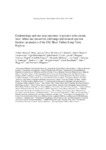Epidemiology and one‐year outcomes in patients with chronic heart failure and preserved, mid‐range and reduced ejection fraction: an analysis of the ESC Heart Failure Long‐Term Registry

View/
Use this link to cite
http://hdl.handle.net/2183/21727Collections
- Investigación (FCS) [1293]
Metadata
Show full item recordTitle
Epidemiology and one‐year outcomes in patients with chronic heart failure and preserved, mid‐range and reduced ejection fraction: an analysis of the ESC Heart Failure Long‐Term RegistryAuthor(s)
Date
2017-04-06Citation
Chioncel O, Lainscak M, Seferovic PM, et al. Epidemiology and one‐year outcomes in patients with chronic heart failure and preserved, mid‐range and reduced ejection fraction: an analysis of the ESC Heart Failure Long‐Term Registry. Eur J Heart Fail. 2017; 19(12): 1574-1585
Abstract
[Abstract] AIMS: The objectives of the present study were to describe epidemiology and outcomes in ambulatory heart failure (HF) patients stratified by left ventricular ejection fraction (LVEF) and to identify predictors for mortality at 1 year in each group.
METHODS AND RESULTS: The European Society of Cardiology Heart Failure Long-Term Registry is a prospective, observational study collecting epidemiological information and 1-year follow-up data in 9134 HF patients. Patients were classified according to baseline LVEF into HF with reduced EF [EF <40% (HFrEF)], mid-range EF [EF 40-50% (HFmrEF)] and preserved EF [EF >50% (HFpEF)]. In comparison with HFpEF subjects, patients with HFrEF were younger (64 years vs. 69 years), more commonly male (78% vs. 52%), more likely to have an ischaemic aetiology (49% vs. 24%) and left bundle branch block (24% vs. 9%), but less likely to have hypertension (56% vs. 67%) or atrial fibrillation (18% vs. 32%). The HFmrEF group resembled the HFrEF group in some features, including age, gender and ischaemic aetiology, but had less left ventricular and atrial dilation. Mortality at 1 year differed significantly between HFrEF and HFpEF (8.8% vs. 6.3%); HFmrEF patients experienced intermediate rates (7.6%). Age, New York Heart Association (NYHA) class III/IV status and chronic kidney disease predicted mortality in all LVEF groups. Low systolic blood pressure and high heart rate were predictors for mortality in HFrEF and HFmrEF. A lower body mass index was independently associated with mortality in HFrEF and HFpEF patients. Atrial fibrillation predicted mortality in HFpEF patients.
CONCLUSIONS: Heart failure patients stratified according to different categories of LVEF represent diverse phenotypes of demography, clinical presentation, aetiology and outcomes at 1 year. Differences in predictors for mortality might improve risk stratification and management goals.
Keywords
Ambulatory
Chronic
Heart failure
Left ventricular ejection fraction
Outcomes
Chronic
Heart failure
Left ventricular ejection fraction
Outcomes
Editor version
Rights
This is the peer reviewed version of the article which has been published in final form at Wiley Online Library. This article may be used for non-commercial purposes in accordance with Wiley Terms and Conditions for self-archiving.
ISSN
1388-9842





